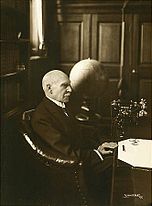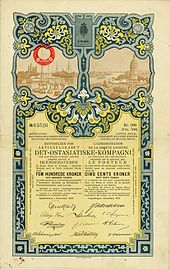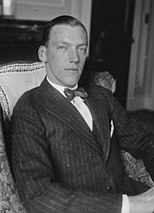Det Østasiatiske Kompagni
| A / S Det Østasiatiske Kompagni The East Asiatic Company A / S (EAC)
|
|
|---|---|
| legal form | Corporation |
| ISIN | DK0010006329 |
| founding | March 27, 1897 |
| Seat | Copenhagen |
| management | Niels Henrik Jensen |
| Number of employees | 3000 (2014) |
| sales | 2.52 billion Danish kroner (2014) |
| Branch | Food and industrial raw materials |
| Website | www.eac.dk |
The A / S East Asiatic Company (OK), known internationally as The East Asiatic Company A / S (EAC), is considered most traditional trading company in Denmark. Until its restructuring in the 1990s, the company was mainly active as a shipping company in liner shipping to the Far East , and since then the EAC has mainly been working in the food and industrial raw materials sectors.
history
Andersen & Co.
The company's roots were laid by Hans Niels Andersen (1852–1937). Andersen left his hometown Nakskov in 1871 and stopped in Liverpool on the Bark Mars , with which he first called Bangkok in 1876 . Andersen took over his first command in 1884 on the Siamese Thom Kramom . After the first trip to Europe with a load of teak , he founded the trading company Andersen & Co. in Bangkok that same year .
Founding years
On March 27, 1897, A / S Det Østasiatiske Kompagni was founded in Copenhagen with a share capital of two million Danish kroner and listed on the Copenhagen Stock Exchange . Isak Glückstadt (1839–1910), the general director of the Landsmandsbanken , was the first chairman of the board . Andersen was appointed managing director. Andersen & Co. in Bangkok was incorporated into the EAC and became the first foreign branch to form the basis of the company specializing in Far East trade. In the same year, the EAC ordered three steamships with a capacity of 6000 tons each and was able to put the first ship into service with the Siam in March 1898 . Shortly afterwards, the company placed its first construction contract with the Copenhagen shipyard Burmeister & Wain , whose first EAC ship, the Annam , began her maiden voyage in 1899. Also in 1899, the administration of the EAC moved to the newly built "Asia House" in the Copenhagen free port , carried out the first capital increase of 1.5 million kroner and founded The Russian East Asiatic Co. Another new establishment was a liner service to the Gulf of Siam which was converted into the independent The Siam Steam Navigation Company in 1907 .
1900-1913
In 1900 the second foreign branch opened in Shanghai, which was soon followed by other Chinese branches. Two years later, the French Est Asiatique Francais and a branch in Singapore with branches in Kuala Lumpur and Penang were founded. A year later the South African Trading Company opened.
After the EAC bought the Mount Austin rubber plantation in 1905, it expanded the rubber trade and quickly acquired additional plantations . The following year, the EAC divided its rapidly growing Far East liner services into a Far East service and a Bangkok service. Soon afterwards, new combi ships were ordered for the latter , which became known as “White Ships”.
In 1908, EAC moved to new corporate headquarters in Copenhagen's Holbergsgade, introduced a pension system and opened the Nørre Sundby Portland cement factory as the company's first industrial production facility. From 1909 the EAC was also traded on the Paris stock exchange and Isak Glückstadt died the following year, whose position was taken over by Holger Petersen (1843-1917). In September of the same year there was a capital increase to 25 million crowns. In 1910 and 1911 the Danish rapeseed cake factory and the Stettiner oil works were founded. Also in 1911, three years before the opening of the Panama Canal , the EAC began a Europe-North Pacific service on the Strait of Magellan and established the first branch in London .
In the last two years before the First World War , the EAC set a milestone in maritime history: in 1912, the Selandia , the first sea-going cargo ship with a diesel engine drive, built by the house shipyard Burmeister & Wain, was put into service. In the following year, the shipping company ordered a whole series of other motor ships.
World wars
The first North American branch was established in San Francisco in 1914, followed by another in New York City in 1916 . In 1915 the EAC took part in the founding of the Danish insurance company Baltica A / S and founded the subsidiary Dampskib Selskab A / S Orient, which took over all of the EAC's remaining steamships. All later EAC cargo ship newbuildings were motor ships. In 1916, on the one hand, Nakskov Skibsværft in Nakskov and, on the other hand, The East Asiatic Industry and Plantation Co. , which took over the operation of the Danish rapeseed cake factory and the plantations on the Malay Peninsula . The following year Holger Petersen died, whose position was taken over by Emil Glückstadt (1875–1923), Isak Glückstadt's son. In 1917 the EAC founded the Baltic America Line , which operated a liner service on the Libau – Danzig – Copenhagen – New York route until 1930 .
A year after the end of the war, EAC and the British Andrew Weir Shipping founded the United Baltic Corporation in London in equal parts , which would later play an important role during the Second World War . The first Indonesian branch was established in Surabaya in 1920 , and from 1923 HN Andersen also served as chairman of the board in addition to his role as managing director. The EAC's first East African branch opened in Dar es Salaam in 1929 .
From 1932, the EAC offered its first transpacific service from the North American west coast to China . The following year, a new branch opened in Madras , soon to be followed by others in Calcutta, Bombay and Hong Kong . In 1937 the EAC began a new service between Europe and India. In the same year, the company's founder, HN Andersen, died, and Prince Axel of Denmark (1888–1964), who had worked at EAC since 1925 and had been managing director since 1932, also became the new chairman. In 1939, EAC opened its first branch in Australia in Sydney . In October of the same year the EAC lost its first ship due to the effects of the war: the Canada sank through a mine off Hull .
When Denmark was occupied by German troops in 1940, Germany confiscated two of the Kompagni's ships and another 17 of the shipping company's ships were out of the country. In the course of the war, the two ships confiscated by Germany, as well as eleven other ships on the Allied side, were lost, killing around 100 seafarers. During these years, Hakon Christiansen headed the international operations as managing director mainly from New York and partly from other neutral countries. In 1942, the EAC acquired its first logging concession in Canada's Gold River District on Vancouver Island . In 1944, the headquarters in Holbergsgade fell victim to a sabotage operation.
post war period
Soon after the end of the war, the EAC began to rebuild the regular organization and in 1949 was able to move into the restored headquarters on Holbergsgade. Also in 1949 the EAC took over the Old East African Trading Company in Mombasa, and the following year the West African company RT Briscoe .
In January 1951, the shipping company Jutlandia was converted to a hospital ship and then served under the auspices of the Danish Red Cross and the United Nations in the Korean War until it returned to regular service with the EAC in 1954. In those years the EAC acquired the Tahsis Co. in Vancouver with all sawmills and other forestry activities on Vancouver Island. In 1953, Prince Axel handed over his position as Managing Director to Hakon Christiansen, but retained the chairmanship of the company. In 1954, the EAC entered the presentation graphics business.
After Hakon Christiansen's death in 1960, Mogens Pagh took over and the EAC Holding Company was founded. In the following year, this took part in the founding of the Danish charter airline Scanair. In 1964 Prince Axel also died, after which Mogens Pagh also took over the chairmanship of the company. In the same year, Prince Axel's son George was elected to the company's board of directors. With the acquisition of the Plumrose canning factory in 1965, the EAC laid the foundation for the reorientation of the company. Two years later, EAC Data was founded in Copenhagen and started exporting grain from Canada to China, from which the EAC alone grew a trading volume of 16 million tons of Canadian wheat to China in the following twelve years.
Containerization and conversion
From 1969 the EAC ordered the first container ships and, due to the high capital requirements for containerization of the liner services, joined several consortia such as Scanservice (from which ScanDutch later grew), Scan Carriers and Johnson ScanStar . In the following year, the financial structure of the largest Scandinavian group (measured in terms of sales) was redesigned. In 1971 a new Europe-West Africa service was opened and production of the Carlsberg Brewery Malaysia Bhd. recorded. The defining event of 1972 is the commissioning of the two new container ships Selandia and Jutlandia . Both ships were delivered by the Copenhagen shipyard Burmeister & Wain and were among the largest and fastest of their kind in the world. Furthermore, the two joint ventures P. T. Danmotors Vespa Indonesi a (motor scooter) and P. T. Danapaints (paints) opened in Indonesia in 1972 . The following year, the EAC took over a majority stake in the sawmill and forest industry company Kauri Timber Company in Tasmania . After a capital increase of the EAC to 765 million crowns and a restructuring in 1978 Henning H. Sparsø were elected managing director in 1980 and TW Schmidt as chairman in 1981.
Crisis and restructuring
After Queen Margrethe and Prince Henrik inaugurated the new Carlsberg Brewery in Hong Kong in 1981 , the EAC suffered heavy economic losses in the following decade, which led to a fundamental restructuring and rationalization of the group, as well as numerous sales, closings, layoffs and several capital increases. In 1992 the EAC suffered a loss of over one billion kroner with a debt burden of 8.9 billion kroner, which in the same year leads to the election of Jan Erlund and Michael Fiorini to the top of the group. Both carried out massive deleveraging and large-scale sales of parts of the company, with the management structure being shifted from country-based responsibilities to the management of business areas. During this phase, the EAC parted ways with the former main line of business, liner shipping.
From 1998, Mark Wilson has been President and CEO of the group. In the years 2002 to 2004, EAC concentrated on the business areas EAC Nutrition, EAC Foods, EAC Industrial Ingredients and EAC Moving & Relocation Services, in which around 97 percent of sales were made. Since then, the regional focus has been on the Asian and South American markets, which is also reflected in the fact that the operational area has been headed from Singapore since 1998. EAC Nutrition was sold on January 1, 2006 and the management was handed over to Niels Henrik Jensen and Michael Østerlund Madsen.
For a while, society consisted of three areas:
- EAC Foods - leader in meat processing in Venezuela . Sold.
- EAC Industrial Ingredients - active in the processing industry in nine countries in South and Southeast Asia. Sold.
As of 2014, the last division, the moving company and the freight forwarding company Santa Fe Group remains :
- EAC Moving & Relocation Services - operates in thirteen countries.
In 2015, the general meeting decided to rename Det Østasiatiske Kompagni to Santa Fe Group.
See also
Individual evidence
- ↑ The EAC at Alacra (English)
literature
- Aktieselskabet Det Ostasiatiske Kompagni . The East Asiatic Company Ltd. Self-published, Copenhagen 1957.
- Povl Westphall: Aktieselskabet Det Ostasiatiske Kompagni . The East Asiatic Company Limited. Self-published, Copenhagen 1972 (English).
Web links
- The EAC at TheShipsList (English)






